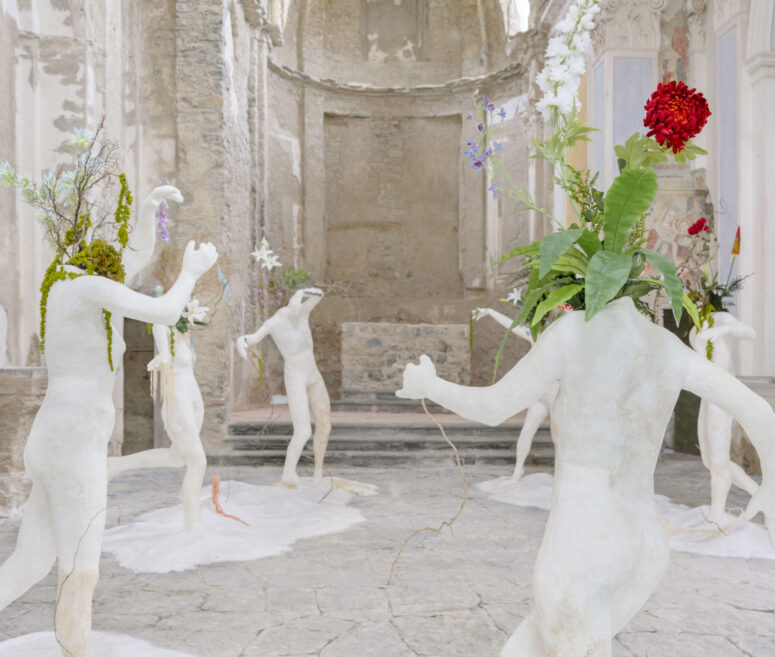Graces for Gerosa was conceived by artist Bianca Bondi (Johannesburg, 1986) specifically for the deconsecrated Romanesque church of Santa Maria in Montanis. Positioned in a strategic location, the church overlooks the landscape of Val Brembilla and the surrounding peaks, facing a network of ancient paths that once connected neighboring valleys. Although it no longer serves its religious function, Santa Maria in Montanis still preserves its evocative power.
Bondi’s project, developed in dialogue with the church’s austere stone architecture, returns to the community a space charged with meaning, heightening its suspended aura and symbolic vocation. At the center of the nave stands a sculptural ensemble of seven life-size figures, created in plaster from the bodies of local volunteers. Each sculpture is born of a direct cast: it is not the external surface that takes precedence, but the interior, which retains with precision the memory of physical presence. In this way, the hollow figures become true interior sculptures — shells that evoke human fossils, mineralized traces of gestures and movements. Like fossils, they preserve the imprint of an existence, offering permanence to those who lent their bodies for the making of the work.
In Graces for Gerosa, particular resonance is given to the reference to a female figure from iconographic tradition, read in art history as an emblem of the Nachleben der Antike (“afterlife of antiquity”): a dancing maiden, light and suspended between corporeality and spirituality. Those qualities of grace and lightness resurface here, embodied not in an abstract ideal but in the concrete physicality of seven volunteers from Gerosa — men and women of different ages. The iconography of the Graces, conceived as figures suggesting cosmic and collective harmony, finds new life in the community of the work, where the human body becomes a medium between the earthly and the immaterial, activating the continuity of gestures and forms through time. The movements, while echoing celebrated depictions of collective dance in art history — from Botticelli’s Three Graces in Primavera (1482), to the female figures in Mantegna’s Parnassus (1497), to the Etruscan ritual scenes of the Tomb of the Triclinium (5th century BCE) — are reimagined through the bodies of Gerosa’s inhabitants: unique bodies, with their own expressiveness, rewriting the original model.
The plaster of the sculptures seems to arise from the very fabric of the building that hosts them, as an ideal extension of Santa Maria in Montanis’s plastered walls. Natural light filtering through the church openings caresses the white surfaces, reflecting on the salt crystallizations scattered across the floor, and contributes to an atmosphere suspended between contemplation and release, spirituality and corporeality. The decision to strip the figures of their faces, replacing them with bouquets of flowers, corals, and crystallized organic matter, not only safeguards the identity of the participants but also transforms each body into a vital vessel of energy and rebirth.
In continuity with Bondi’s broader practice, Graces for Gerosa is rooted in her ongoing exploration of rituality and organic transformation. In her work, Bondi combines installation, sculpture, and performance with materials in constant flux — dried flowers, water, crystals, pigments, salt — creating environments that behave as autonomous ecosystems, evolving over time. Her site-specific installations often activate collective rituals and spaces for sensory meditation, opening up the possibility of conceiving different exhibition sites as living organisms, permeable to change and to natural forces. Moving along the threshold between life and decay, Bondi creates environments that assume the form of shared ceremonies. Each natural element becomes an instrument of metamorphosis and rebirth.
Historically, dance was forbidden in sacred spaces, deemed an irreverent act. With Graces for Gerosa, this taboo is overcome: movement returns to the church not as rebellion but as reconciliation, a ritual that restores to the human body its role as a bridge between the earthly and the immaterial. Dance thus becomes a universal language of union and collective celebration.





